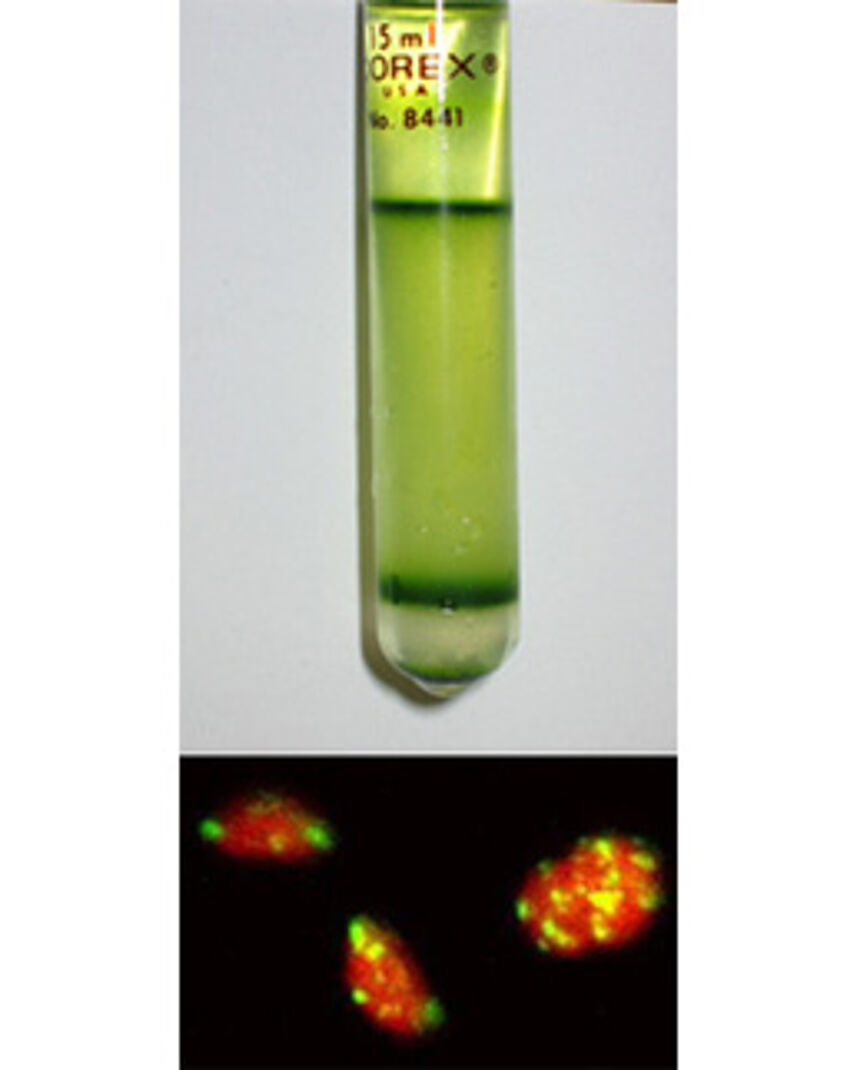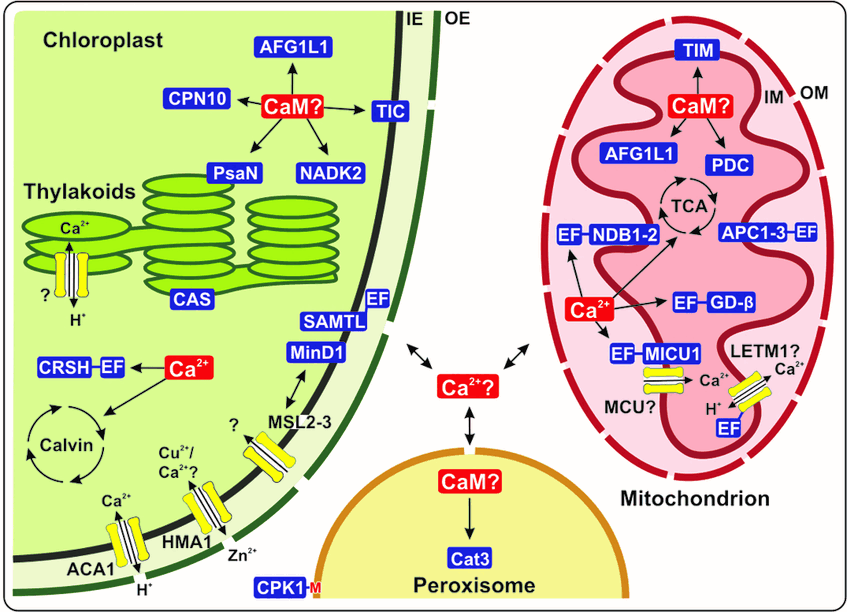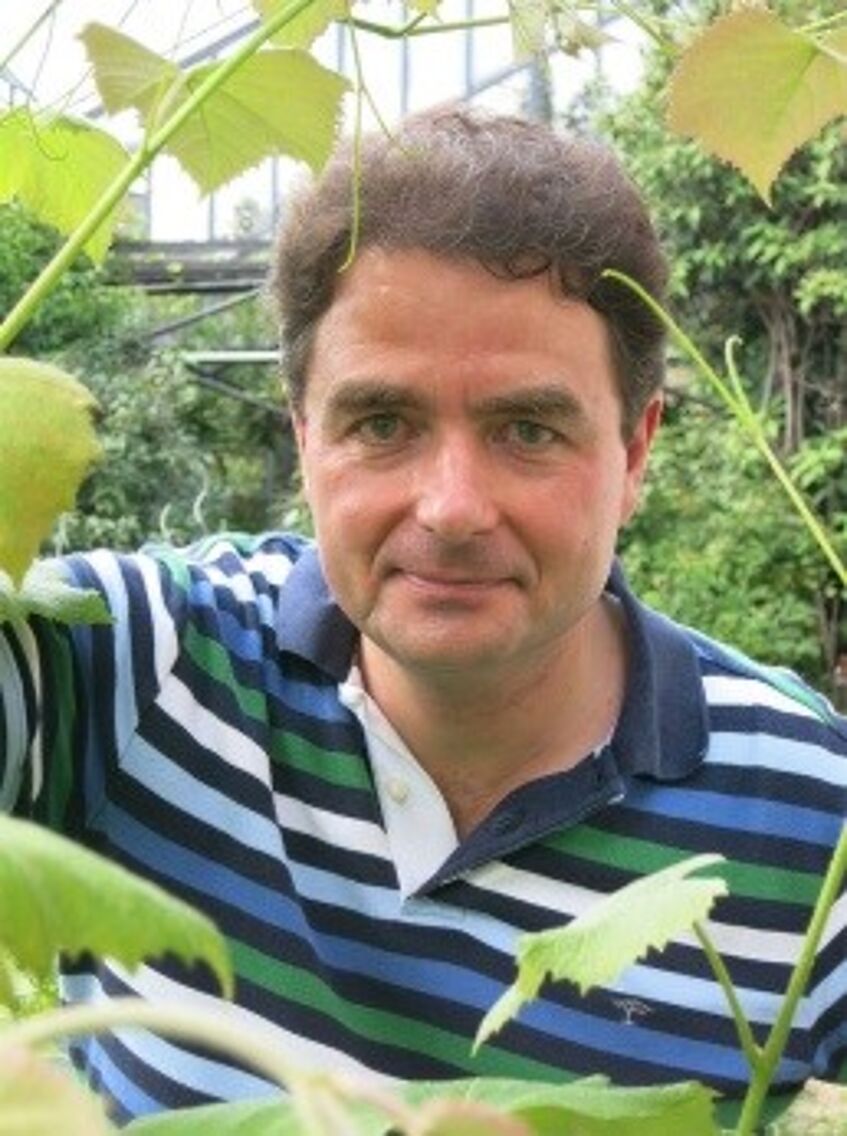Plant Signalling - Markus Teige group
Room: 3.055
Djerassiplatz 1
1030 Vienna, Austria
+43-1-4277-76530
markus.teige@univie.ac.at

l.t.r: Dr. Anna Zvereva, Andrea Mair, Michele Grieco, Dr. Markus Teige, Dr. Verena Schön, Dr. Bernhard Wurzinger, Mag. Przemyslaw Kmiecik
Research Focus
We study how plants adapt and acclimate to a changing environment or to stress conditions. How are environmental signals perceived and further processed in plants, and which processes are regulated? To answer these questions, we investigate different pathways, which are triggered by calcium-signals and test different mutants for a physiological phenotype. We are particularly interested in the subcellular localization of the signalling molecules with a special focus on chloroplast-related metabolism.

Therefore we performed directed proteomic studies and bioinformatics in order to identify new signalling components in chloroplasts (Bayer et al. 2011, 2012, 2014, and 2015) and studied effects of protein modification in the subcellular targeting of protein kinases (Stael et al. 2011 and 2012). Detailed functional studies of chloroplast-related signalling were initially performed within the Marie-Curie training network (ITN) COSI and are now being followed-up in the framework of the newly funded Marie-Curie ITN CALIPSO. Within this network of 9 European Universities and 3 private partners we study Ca2+- and light-signalling pathways in photosynthetic organisms.
Image: Isolated Arabidopsis chloroplasts on a Percoll gradient (upper part) and three chloroplasts expressing a green-fluorescent protein (GFP) fusion. Red, Chlorophyll-fluorescence; green, YFP signal.
The decoding of calcium signals by calcium-dependent protein kinases (CDPKs) serves as example for stress acclimation. We identified a CDPK, which is required for acclimation to salt-stress (Mehlmer et al. 2010; Latz et al. 2013). This CDPK seems to regulate different cellular targets at the vacuole, the plasma membrane, in the cytosol, and also in the nucleus. Mechanisms of metabolic reprogramming in response to different growth conditions were further addressed in the Marie-Curie Training Network (ITN) MERIT. Here we analysed the regulation of the bZIP transcription factor bZIP63 by phosphorylation in collaboration with eight European partner groups. A major outcome of this project was the discovery of a novel mechanism regulating the combinatorial control of gene expression by bZIP transcription factors. We found that bZIP63, a transcription factor of the C-class of bZIPs, is phosphorylated by CPK3 in a Ca2+ -dependent manner, and by SnRK1 in response to the energy status of the cell (Mair et al. 2015). The phosphorylation of bZIP63 at three highly conserved sites in the very N- and C-terminal ends is indeed required for its biological function for metabolic reprograming in response to starvation. The phosphorylation triggers a switch of hetero-dimerization and thereby alters downstream gene expression.

Phosphorylation of the bZIP transcription bZIP63 by the energy sensing kinase SnRK1 mediates dimerization of the bZIP transcription factors for acclimation to low-energy stress as described in the paper by Maier et al., 2015 in eLife.
Future directions of our work will be to untangle how phosphorylation of these transcription factors regulates the activity and thereby the expression of downstream genes, and to study newly discovered factors in chloroplast signalling. A particular focus in this aspect will be the decoding of calcium signals in the chloroplast.
Links to international projects
CALIPSO: http://itn-calipso.univie.ac.at
MERIT: http://theory.bio.uu.nl/MERIT/html/index.html
COSI: http://www.univie.ac.at/cosi
CROPP: http://www.gen-au.at/projekt.jsp?projektId=116&lang=de
FWF projects
P28491 Cross-talk of Calcium- and Energy Signalling in Plants (CESP) (2016-2018)
One current project, funded by the FWF since 2016, addresses two major aspects of plant energy and stress signalling: (i) The cross-talk between calcium- and energy-dependent signalling pathways in plants’ responses to stress, and (ii) The importance of the subcellular localization of these signalling events. These are fundamental research questions to understand signalling in general in all eukaryotic cells as the involved principal signalling mechanisms are evolutionary highly conserved in animal, yeast, and plant cells. How do CDPKs and SnRKs mediate appropriate responses in the cellular or organismal context, are they active under different conditions, for example in response to different stimuli, and how do they influence each other and how do they regulate organellar events such as photosynthesis? And finally, do they function at the same subcellular localization or could a spatial/temporal separation of the signalling pathways be an explanation for the apparent redundancy?

P25359 Protein phosphorylation and calcium signals in chloroplasts (2012-2015)

Overview of components involved in organellar Ca2+ signalling in plants (from Stael et al. 2012).
P25359 Protein phosphorylation and calcium signals in chloroplasts (2012-2015)
Chloroplast metabolism is ultimately linked to plant productivity and needs to be quickly regulated in response to changing environmental conditions. A deeper understanding of the involved regulatory mechanisms is essential to be able to improve future yields and performance of crops. Chloroplasts are integrated into the signalling network of the entire cell. In addition to the predominant redox regulation in chloroplasts, reversible protein phosphorylation is a key mechanism for the regulation of cellular processes and for signal transduction in response to environmental changes.
This project aimed at the functional characterization of newly identified regulatory proteins in chloroplasts including a novel protein kinase, and calcium-binding proteins. Furthermore we investigated the impact of calcium-dependent phosphorylation on chloroplast metabolism using different targets of phosphorylation.
Publications
- Wurzinger B, Mair A, Fischer-Schrader K, Nukarinen E, Roustan V, Weckwerth W, Teige M* (2017) Redox state-dependent modulation of plant SnRK1 kinase activity differs from AMPK regulation in animals. FEBS Letters 591(21):3625-3636. doi: 10.1002/1873-3468.12852. PMID: 28940407
- Nukarinen E, Nägele T, Pedrotti L, Wurzinger B, Mair A, Landgraf R, Börnke F, Hanson J, Teige M, Baena-Gonzalez E, Dröge-Laser W, Weckwerth W* (2016) Quantitative phosphoproteomics reveals the role of the AMPK plant ortholog SnRK1 as a metabolic master regulator under energy deprivation. Scientific Reports, 6:31697, doi: 10.1038/srep31697. PMID: 27545962
- Roustan V, Jain A, Teige M, Ebersberger I*, Weckwerth W* (2016) An evolutionary perspective of AMPK-TOR signaling in the three domains of life. J Exp Bot 67(13): 3897-3907. doi: 10.1093/jxb/erw211. PMID: 27270999
- Simeunovic A, Mair A, Wurzinger B, Teige M* (2016) Know where your clients are – subcellular localization and targets of Ca2+-dependent protein kinases. J Exp Bot 67(13): 3855-3872. doi: 10.1093/jxb/erw157. PMID: 27117335
- Grieco M, Jain A, Ebersberger I, Teige M* (2016) An evolutionary view on thylakoid protein phosphorylation to uncover novel phosphorylation hotspots with potential functional implications. J Exp Bot 67(13): 3883-3896. doi: 10.1093/jxb/erw164. PMID: 27117338
- Kmiecik P, Leonardelli M, Teige M* (2016) Novel connections in plant organellar signalling link different stress responses and signalling pathways. J Exp Bot 67(13): 3793-3807. doi: 10.1093/jxb/erw136. PMID: 27053718
- Crozet P, Margalha L, Butowt R, Fernandes N, Elias C, Orosa B, Tomanov K, Teige M, Bachmair A, Sadanandom A, Baena-Gonzalez E (2016) SUMOylation represses SnRK1 signaling in Arabidopsis. Plant J 85(1):120-133. doi: 10.1111/tpj.13096. PMID: 26662259
- Mair A, Pedrotti L, Wurzinger B, Anrather D, Simeunovic A, Weiste C, Valerio C, Dietrich K, Kirchler T, Nägele T, Vicente Carbajosa J, Hanson J, Baena-González E, Chaban C, Weckwerth W, Dröge-Laser W, Teige M* (2015) SnRK1-triggered switch of bZIP63 dimerization mediates the low-energy response in plants. eLife 2015; 10.7554/eLife.05828 PMID:26263501
(recommended by F1000Prime http: http://f1000.com/prime/725713006) - Bayer RG, Stael S, Teige M* (2015) Chloroplast isolation and affinity chromatography for enrichment of low-abundant proteins in complex proteomes. Methods Mol Biol. 1295:211-23. PMID: 25820724
- Stael S, Kmiecik P, Willems P, Van Der Kelen K, Coll NS, Teige M, Van Breusegem F (2015) Plant innate immunity--sunny side up? Trends Plant Sci 20: 3-11 PMID: 25457110
- Bayer RG, Kostler T, Jain A, Stael S, Ebersberger I, Teige M* (2014) Higher plant proteins of cyanobacterial origin: are they or are they not preferentially targeted to chloroplasts? Mol Plant 7: 1797-1800 PMID: 25178282
- Khan M, Rozhon W, Unterholzner SJ, Chen T, Eremina M, Wurzinger B, Bachmair A, Teige M, Sieberer T, Isono E, Poppenberger B (2014) Interplay between phosphorylation and SUMOylation events determines CESTA protein fate in brassinosteroid signalling. Nat Commun 5: 4687 PMID: 25134617
- Nägele T, Mair A, Sun X, Fragner L, Teige M, Weckwerth W (2014) Solving the differential biochemical Jacobian from metabolomics covariance data. PLoS One 9: e92299 PMID: 24695071
- Rocha AG, Mehlmer N, Stael S, Mair A, Parvin N, Chigri F, Teige M, Vothknecht UC (2014) Phosphorylation of Arabidopsis transketolase at Ser428 provides a potential paradigm for the metabolic control of chloroplast carbon metabolism. Biochem J 458: 313-322 PMID: 24328790
- Schulz P, Jansseune K, Degenkolbe T, Meret M, Claeys H, Skirycz A, Teige M, Willmitzer L, Hannah MA (2014) Poly(ADP-ribose)polymerase activity controls plant growth by promoting leaf cell number. PLoS One 9: e90322 PMID: 24587323
- Stanko V, Giuliani C, Retzer K, Djamei A, Wahl V, Wurzinger B, Wilson C, Heberle-Bors E, Teige M*, Kragler F* (2014) Timing is everything: highly specific and transient expression of a MAP kinase determines auxin-induced leaf venation patterns in Arabidopsis. Mol Plant 7: 1637-1652 PMID: 25064848
- Latz A, Mehlmer N, Zapf S, Mueller TD, Wurzinger B, Pfister B, Csaszar E, Hedrich R, Teige M*, Becker D* (2013) Salt Stress Triggers Phosphorylation of the Arabidopsis Vacuolar K+ Channel TPK1 by Calcium-Dependent Protein Kinases (CDPKs). Mol. Plant. 6: 1274-1289. PMID: 23253603
- Khan M, Rozhon W, Bigeard J, Pflieger D, Husar S, Pitzschke A, Teige M, Jonak C, Hirt H, Poppenberger B. (2013) Brassinosteroid-regulated GSK3/Shaggy-like kinases phosphorylate mitogen-activated protein (MAP) kinase kinases, which control stomata development in Arabidopsis thaliana. J. Biol. Chem. 288(11):7519-27. doi: 10.1074/jbc.M112.384453. PMID: 23341468
- Mair A, Teige M. (2012) Shaping the pathogen response by protein kinase triggered oxidative burst. New Phytol. 196(1):4-6. doi: 10.1111/j.1469-8137.2012.04293.x. PMID: 22924402
- Schulz P, Neukermans J, Van der Kelen K, Mühlenbock P, Van Breusegem F, Noctor G, Teige M, Metzlaff M, Hannah MA. (2012) Chemical PARP inhibition enhances growth of Arabidopsis and reduces anthocyanin accumulation and the activation of stress protective mechanisms. PLoS One. 7(5):e37287. doi: 10.1371/journal.pone.0037287. PMID:22662141
- Bayer RG, Stael S, Rocha AG, Mair A, Vothknecht UC, Teige M. (2012) Chloroplast-localized protein kinases: a step forward towards a complete inventory. J. Exp. Bot. 63(4):1713-23. doi: 10.1093/jxb/err377. PMID:22282538
- Mehlmer N, Parvin N, Hurst CH, Knight MR, Teige M, Vothknecht UC. (2012) A toolset of aequorin expression vectors for in planta studies of subcellular calcium concentrations in Arabidopsis thaliana. J. Exp. Bot. 2012 63(4):1751-61. doi: 10.1093/jxb/err406. Epub 2012 Jan 2. PMID:22213817
- Stael S, Wurzinger B, Mair A, Mehlmer N, Vothknecht UC, Teige M. (2012) Plant organellar calcium signalling: an emerging field. J. Exp. Bot. 63(4):1525-42. doi: 10.1093/jxb/err394. PMID:22200666
- Stael S, Rocha AG, Wimberger T, Anrather D, Vothknecht UC, Teige M. (2012) Cross-talk between calcium signalling and protein phosphorylation at the thylakoid. J. Exp. Bot. 63(4):1725-33. doi: 10.1093/jxb/err403. PMID:22197893
Group leader

Group leader
Markus Teige
Faculty of Life Sciences, University of Vienna
Althanstrasse 14, A-1090 Vienna
e-mail: Markus.Teige@univie.ac.at
http://mosys.univie.ac.at/team/markus-teige/
· Current position: Group leader Plant Signalling at the Department of Ecogenomics & Systems Biology at the University of Vienna (AT)
· 1992 Diploma in Chemistry at the Leibniz University of Hannover (DE)
· 1992-1995 PhD in Biochemistry on regulation of Calvin-cycle enzymes at the IPK Gatersleben (DE)
· 1995-1996 Humboldt postdoctoral fellowship with Paul A. Srere at UT Southwestern, Dallas, TX (USA) to study multi-enzyme complexes of TCA cycle enzymes in yeast mitochondria
· 1998-2000 Marie Curie individual fellowship with Helmut Ruis at the University of Vienna to investigate stress responses of yeast and plant cells
· 2000-2004 Senior postdoc with Heribert Hirt at the University of Vienna to study MAP kinase signalling and stress responses in plants
· 2002 Habilitation: Venia docendi for Biochemistry from the University of Salzburg
· Since 2004 Self-funded group leader at the University of Vienna with projects on Ca2+ dependent protein kinases and organellar signalling
Key publications
Mair A, Pedrotti L, Wurzinger B, Anrather D, Simeunovic A, Weiste C, Valerio C, Dietrich K, Kirchler T, Nägele T, Vicente Carbajosa J, Hanson J, Baena-González E, Chaban C, Weckwerth W, Dröge-Laser W, Teige M* (2015) SnRK1-triggered switch of bZIP63 dimerization mediates the low-energy response in plants. eLife 2015; 10.7554/eLife.05828.
Mehlmer N, Wurzinger B, Stael S, Hofmann-Rodrigues D, Csaszar E, Pfister B, Bayer R, Teige M* (2010) The Ca2+ -dependent protein kinase CPK3 is required for MAPK-independent salt-stress acclimation in Arabidopsis. Plant J 63: 484-498.
Teige M*, Scheikl E, Eulgem T, Doczi R, Ichimura K, Shinozaki K, Dangl JL, Hirt H* (2004) The MKK2 pathway mediates cold and salt stress signaling in Arabidopsis. Mol Cell 15: 141-152.
Teige M, Scheikl E, Reiser V, Ruis H, Ammerer G (2001) Rck2, a member of the calmodulin-protein kinase family, links protein synthesis to high osmolarity MAP kinase signaling in budding yeast. Proc Natl Acad Sci U S A 98: 5625-5630.
